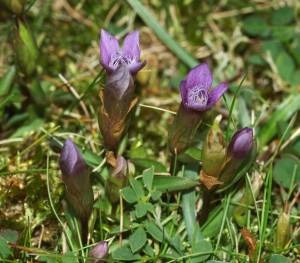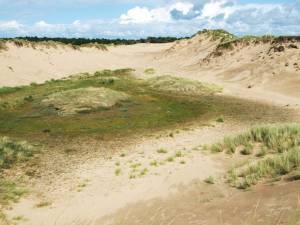Dr Phil Smith’s Wildlife Notes
September 2009
In August’s notes, I mentioned the Field Gentian survey that Patricia Lockwood and I had started on Ainsdale Sand Dunes National Nature Reserve. Because of its recent decline, this beautiful wild flower has been highlighted by the Botanical Society of the British Isles as a “threatened plant”. We knew there were large numbers in the NNR but no-one had ever counted them. In the event, helped on several occasions by Dr Mary Dean, it took us 20 visits to complete our, often exhausting, search of 88ha of open dunes. We mapped over 350 sites containing Field Gentians, the final total being an extraordinary 140,700 plants (and we must have missed lots!). Most of them were found in dry-slacks or around the fringes of wet-slacks and nearly all were in vegetation that was heavily rabbit-grazed and also fenced for winter-grazing by sheep. The greatest concentrations of gentians were in the so-called Dune Restoration Area where pine trees and scrub were removed in the early 1990s. Thus, two large slacks here supported 47,000 and 31,000 plants respectively. We also found thousands of the related Autumn Gentian (Gentianella amarella), which is more common nationally.

The only other place in southern Britain with flourishing populations of Field Gentian is the New Forest, where recent counts suggest high tens-of-thousands. The plant is still widespread in Scotland but I understand the biggest concentrations are only of a few thousands. It seems then that Ainsdale NNR is the best site in Britain for this species, which is also red-listed as endangered in many European countries.
As a welcome break from gentian spotting, Pat and I visited the Devil’s Hole, Ravenmeols, on 12th September to record the vegetation colonising the floor of this double blow-out that began to form in the early 1940s. We identified 67 plants in the northern basin, which has been flooding in wet winters since the early 1990s, and 30 in the southern hollow, which held water for the first time in 2008. Ten of the plants are regionally or nationally notable, including Grass-of-Parnassus, Blunt-flowered Rush and two species of orchid. Most of these have appeared since the last survey five years ago when only 16 plants were found. The Devil’s Hole is important as one of very few examples on the coast of a recently formed dune-slack created by wind-blow, most of the dune system being so overgrown that such features are now rare.

September is usually a good month for grasshoppers and crickets. Although we have only four kinds (three grasshoppers, one groundhopper and one bush-cricket), they can be abundant locally and make attractive, if challenging, subjects for close-up photography. I spent an entertaining hour on 20th with Short-winged Coneheads at Tagg’s Island Birkdale. These 2cm-long bush-crickets first appeared in our region as recently as 2002 and are always alert to danger, dodging behind plant stems when the camera lens approaches. With patience, however, it is possible to get pictures.
I also took my camera on 14th when Trevor Davenport phoned to say he had caught a Convolvulus Hawkmoth in his Freshfield moth-trap. This great rarity is one of the largest British insects and was a new tick for me. We managed to unfurl its four-inch proboscis and give it a drink of sugar-water. This had the desired effect, as it flew away shortly afterwards.
